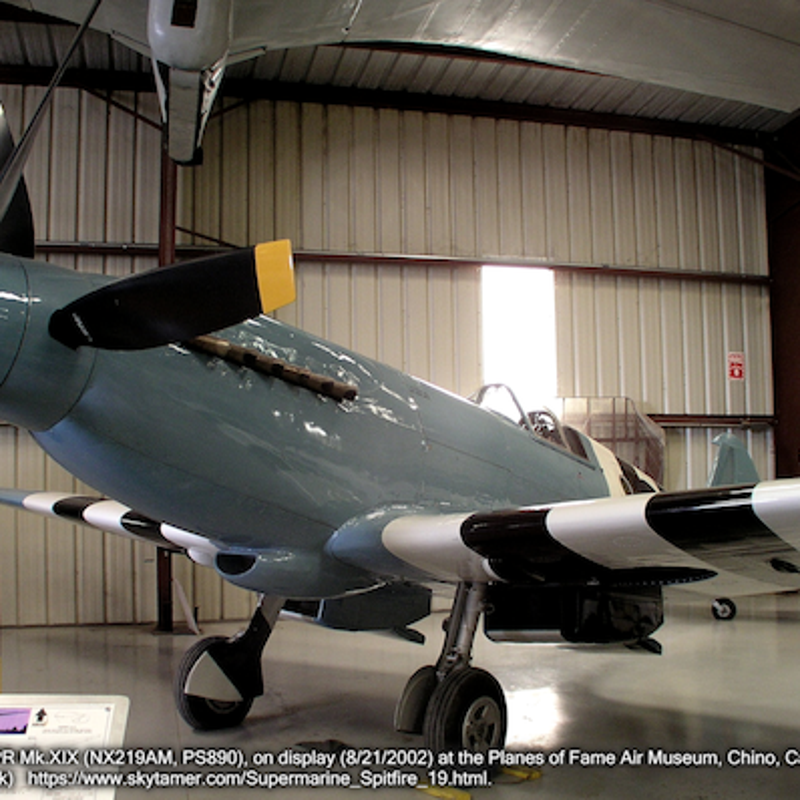Popular: Combe Martin Events 2024 | Hunting the Earl of Rone | Silver Mining | Combe Martin Museum | Industrial History |
Combe Martin Flying Officer John Neville Rowbotham
Royal Air Force (Volunteer Reserve) World War II
Killed in Action on 29.11.44
Feature article posted on April 25, 2024
Last modified on 2024-10-30 at 11:30 UTC
TRANQUIL YOU LIE, YOUR KNIGHTLY VIRTUE PROVED, YOUR MEMORY HALLOWED,
IN THE LAND YOU LOVED
In St. Peter ad Vincula Combe Martin churchyard, lies Flying Officer (Pilot 160133) John Neville Rowbotham, of 541 Squadron RAF (VR). John was killed in action while on a mission to Hamburg on 29.11.1944, at the age of 23.
Known Details
According to the Aviation Safety Network, on 29.11.44, John flew his Supermarine Spitfire Mk XIX or Mk XI from RAF Benson, Oxon, to RAF Bradwell Bay, Essex. John's aircraft, tail number PR PL887, crashed in to the sea off RAF Bradwell Bay and was destroyed (RAF Commands).
There is some discrepancy with tail number PR PL887. In some reports, F/O Rowbotham's Spitfire was a Mk XI; in others it was a Mk XIX. The Spitfire Mk XIX was the final and most effective photo reconnaissance version of the Spitfire. It merged characteristics of the Mk XI with the power of the Mk XIV’s Griffon.
Gazetted in 1944
John Neville Rowbotham is listed in Supplements to The London Gazette, published 28 January 1944 and 13 June 1944.
War Grave Burial
John's war grave is in the new ground west part of St Peter's churchyard, Grave 62. Refer to Findagrave.com. Turn right at the north gate to find John's CWGC grave on the hill to the west. His mother's name, Coralie, is also on the stone.
Unit and Family Information
John Neville Rowbotham was the son of Capt. Victor S. Rowbotham; formerly R.F.C., and of Coralie A. Rowbotham, of Umberleigh. His unit, 541 Squadron RAF (VR), was one of the Photographic Reconnaissance Units (PRU) gathering Intelligence over enemy territory during World War II.
RAF Photographic Reconnaissance Units WW2
“Spies in the Skies” during the Second World War, Allied PRU pilots flew lone photographic reconnaissance missions deep into enemy territory, mostly unarmed and without protection.
The aircraft were known as 'PRU Blue' or 'recce Spitfires'. The Mk XIX was unarmed and could carry two vertical cameras, and/or one oblique camera in a heated compartment aft of the cockpit.
541 squadron formed at RAF Benson on 19 October 1942 from 'B' and 'F' flights of No. 1 PRU, and was equipped with Spitfires to fly missions over Europe. The squadron was also equipped with North American P-51 Mustangs during 1944.
These lone ‘Bird’s Eye’ ops were highly dangerous, and almost 500 of these pilots lost their lives. Currently there are plans to erect a National Memorial to them.
RAF PRU missions added vital Intelligence to the information gathered by the Special Operations Executive (SOE) on the ground, and to the Bletchley Park code-breakers through the airwaves. Work was carried out for the Navy, the Army, for the Intelligence Services, and for the various other RAF commands.
PRU pilots photographed locations and movements of enemy supplies, men, ships and planes, giving Allied commanders and Intelligence interpreters crucial up to date information.
This information has been condensed for our website. However, The Spitfire AA810 Project is dedicated to the memory of all the personnel of the Photographic Reconnaissance Unit (PRU) who risked, and gave, their lives during the Second World War.
The Mk XIX Supermarine Spitfire
The Spitfire Mk XIX was the final and most effective photographic reconnaissance model. It integrated the Mk XI’s features with the Mk XIV’s Griffon engine. The first 25 units produced were type 389s (Dr Alfred Price 2002, p. 217).
The Spitfire PR XIX, powered by a Griffon 66 engine, was a high-performance aircraft. Its top speed is reported to be between 445 mph and 460 mph. This speed was achievable at an altitude of approximately 26,000 feet (weapons andwarfare.com, 2020).
Subsequent aircraft were equipped with the Mk X’s pressurised cabin and the fuel capacity was expanded to 256 gallons, which is three and a half times the original Spitfire’s capacity. This model was known as the type 390.
The Mk XIXs were first introduced in service in May 1944. By the end of World War II, they had almost completely replaced the earlier Mk XI. A total of 225 units were manufactured before production ended in early 1946. However, they remained in active RAF service until April 1954.
Proposals for a National Memorial
A Westminster Hall debate on a ‘National Memorial to the Photographic Reconnaissance Unit’ was scheduled for Tuesday 9 November 2021, alongside discussions with the Spitfire AA810 project to erect a new permanent memorial.
From 1939 to 1945, some 1,500 Spitfire pilots from 21 countries flew thousands of dangerous reconnaissance missions over Europe, providing photographs of enemy movements and targets.
Sources accessed 2023-2024:
AIR 27 National Archives | Air Ministry and successors: Operations Record Books, Squadrons.
Air of Authority - A History of RAF Organisation: No 541 - 598 Squadron Histories.
Aviation-safety.net: Spitfire PL887: T/o at 12:57hrs for PR mission Hamburg. Crashed in sea on 29.11.1944. Crew: Flying Officer (160.133) John Neville ROWBOTHAM (pilot) RAFVR – killed.
CWGC.org Casualty Lists ; Combe Martin St Peter ad Vincula Churchyard.
https://commonslibrary.parliament.uk/research-briefings/cdp-2021-0180/.
RAF Bradwell Bay Preservation Group: https://rafbradwellbay.co.uk/.
RAF Commands: Flying Officer John Neville ROWBOTHAM (160133).
RAF and Commonwealth Air Forces Roll of Honour: Flying Officer John Neville Rowbotham.
RAF Web - 541 Squadron RAF 1944. https://www.rafweb.org/Squadrons/Sqn541-598.htm.
The Imperial War Museum (IWM).
Explore More of Combe Martin's History
Discover the rich heritage of our village and the remarkable individuals who have shaped it.
![Combe Martin Village History [The Little Parish with a Big Story] Combe Martin Village History [The Little Parish with a Big Story]](https://primary.jwwb.nl/public/i/j/k/temp-bexcyixkrnloblaipglr/cmvhp-logo-01-june-2025-high.png?enable-io=true&enable=upscale&height=70)
![Combe Martin Village History [The Little Parish with a Big Story] Combe Martin Village History [The Little Parish with a Big Story]](https://primary.jwwb.nl/public/i/j/k/temp-bexcyixkrnloblaipglr/cmvhp-logo-01-june-2025-high.png?enable-io=true&width=100)




